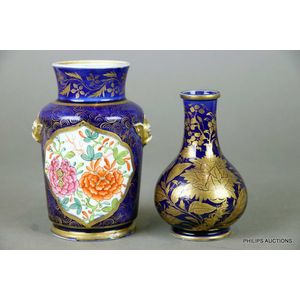Masons Ironstone Vases and Oriental Style High-Shouldered Vase
Two Masons ironstone vases, circa 1813-1925 and after, a small cobalt bottle vase with gilded floral designs, and an oriental style high shouldered vase with a broad neck, bat moulded lug handles and decorated with two shaped cartouches with polychrome chrysanthemums upon a scrolling gilt and cobalt ground; the latter marked Masons patent Ironstone china, height 12.5 cm, and 10.5 cm
You must be a subscriber, and be logged in to view price and dealer details.
Subscribe Now to view actual auction price for this item
When you subscribe, you have the option of setting the currency in which to display prices to $Au, $US, $NZ or Stg.
This item has been sold, and the description, image and price are for reference purposes only.
- Gilding - Gilding is a method of ornamentation whereby a thin sheet of gold metal is applied to items made of wood, leather, ceramics, glass and silver for decorative purposes.
For furniture including mirrors, the sheet of gold is usually applied over a coating of gesso. Gesso is a mixture of plaster of Paris and gypsum mixed with water and then applied to the carved wooden frames of mirrors and picture frames as a base for applying the gold leaf. After numerous coats of gesso have been applied, allowed to dry and then sanded a coat of "bole", a usually red coloured mixture of clay and glue is brushed on and allowed to dry, after which the gold leaf is applied. Over time parts of the gilding will rub off so the base colour can be seen. In water gilding, this was generally a blue colour, while in oil gilding, the under layer was often yellow. In Victorian times, gilders frequently used red as a pigment beneath the gold leaf.
Metal was often gilded by a process known as fire gilding. Gold mixed with mercury was applied and heated, causing the mercury to evaporate, the long-term effect of which was to kill or disable the craftsman or woman from mercury poisoning. The pursuit of beauty has claimed many victims, not the least of which were the artists who made those pieces so highly sought after today. - Circa - A Latin term meaning 'about', often used in the antique trade to give an approximate date for the piece, usually considered to be five years on either side of the circa year. Thus, circa 1900 means the piece was made about 1900, probably between 1895 and 1905. The expression is sometimes abbreviated to c.1900.
- Polychrome - Made or finished in many colours. For furniture, it is used to indicated a painted finish.
- Ironstone China - Credit for the invention of ironstone china is generally accorded to Charles Mason in 1813. Charles Mason was one of the two sons of Miles Mason who founded the Mason works in 1802, and ran the business with his brother George Mason.
Ironstone was a heavy hard earthenware which was slightly translucent, its strength supposedly coming from a very small quantity of iron slag added to the mixture. The additional strength enabled the company to make larger objects that were not susceptible to breakage.
The company manufactured dinner wares, toilet sets, tureens, jugs and so on, and the most popular patterns were blue and white, floral and Oriental Imari style colours.
The trade name "Patent Ironstone China" was registered by the company in 1813, but the patent was only valid for 14 years and was not renewed, enabling other potteries to use the word "ironstone" in describing their wares.
Mason wares are generally well marked with "Mason's Patent Ironstone China" .
This item has been included into following indexes:
Visually similar items

A pair of Cantonese enamel miniature vases, Chinese Qing Dynasty. 12 cm high
Sold by
in
for
You can display prices in $Au, $US, $NZ or Stg.

A Chinese blue and white floor vase decorated with dragons chasing flaming pearl in the clouds motif. Height 63 cm
Sold by
in
for
You can display prices in $Au, $US, $NZ or Stg.

Two Chinese blue and white ceramic vases height 23.5 cm approx (tallest)
Sold by
in
for
You can display prices in $Au, $US, $NZ or Stg.

Two Chinese eggshell porcelain vases Republic period, with calligraphy. In boxes
Sold by
in
for
You can display prices in $Au, $US, $NZ or Stg.
